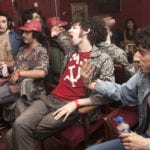 Mysteries
Mysteries  Mysteries
Mysteries  History
History 10 Surprising Stories About the Texas Rangers
 Humans
Humans 10 Philosophers Who Were Driven Mad by Their Own Theories
 Miscellaneous
Miscellaneous 10 Video-Game-Worthy Weapons and Armors from History
 Weird Stuff
Weird Stuff 10 Psychics Who Accurately Predicted Wartime Events
 The Arts
The Arts 10 Pieces of Art Inspired by a Broken Heart
 Health
Health 10 Science Fiction-Sounding New Medical Treatments
 History
History 10 Surprising Facts About the Father of Submarine Warfare
 Space
Space Ten Astonishing New Insights into Alien Worlds
 Weird Stuff
Weird Stuff 10 Bizarre Summer Solstice Rituals Still Practiced Today
 Mysteries
Mysteries Top 10 Haunting Facts About the Ghost Ship MV Alta
 History
History 10 Surprising Stories About the Texas Rangers
 Humans
Humans 10 Philosophers Who Were Driven Mad by Their Own Theories
Who's Behind Listverse?

Jamie Frater
Head Editor
Jamie founded Listverse due to an insatiable desire to share fascinating, obscure, and bizarre facts. He has been a guest speaker on numerous national radio and television stations and is a five time published author.
More About Us Miscellaneous
Miscellaneous 10 Video-Game-Worthy Weapons and Armors from History
 Weird Stuff
Weird Stuff 10 Psychics Who Accurately Predicted Wartime Events
 The Arts
The Arts 10 Pieces of Art Inspired by a Broken Heart
 Health
Health 10 Science Fiction-Sounding New Medical Treatments
 History
History 10 Surprising Facts About the Father of Submarine Warfare
 Space
Space Ten Astonishing New Insights into Alien Worlds
 Weird Stuff
Weird Stuff 10 Bizarre Summer Solstice Rituals Still Practiced Today
10 Filmmakers Who Went to Extreme Lengths to Make Their Movies
Sometimes, the unthinkable happens on a film set by accident, and sometimes, it is by design. Certainly, it is not uncommon for a director to make larger-than-life demands, ordering the seas to part in order to get the perfect shot. However, some have gone further than others to achieve this, taking what might be considered barely achievable and turning it up to 11.
In the name of creativity, authenticity, and sheer audacity, these filmmakers have thrown caution to the wind and pioneered technological innovations, constructed unthinkable structures, pushed actors to the limit, and gone to extreme lengths in order to make the movie they wanted.
Related: Top 10 Underappreciated Directorial Debuts You Need To See
10 Abel Gance Created a New Format (Napoléon, 1927)
Long before Ridley Scott touched the story of the infamous French commander, Abel Gance made the deeply influential silent movie Napoléon. Telling the story of Napoleon Bonaparte’s life from military school to the invasion of Italy, the 330-minute mega-epic is lauded as a cinematic masterpiece, pioneering a sweeping, fluid camera style that ran contrary to the primarily static convention for creating shots at the time.
While a variety of innovative techniques were employed in the making of Napoléon, including surreal use of color, multiple exposure, and kaleidoscopic images, the most significant innovation was Gance’s invention of a whole new film format.
The director created Polyvision, a bespoke format designed to fulfill his vision for the film’s panoramic climax. Three times the width of the standard projection at the time and still considerably wider than any aspect ratio used today, Gance’s Polyvision involved stacking three cameras together while shooting his sequences and three projectors side-by-side in order to project it. Needless to say, the format never took off, but the scope, ambition, and final product are all uniquely impressive.[1]
9 Terry Gilliam’s Giant Windmill (The Man Who Killed Don Quixote, 2018)
Absurdist filmmaker extraordinaire Terry Gilliam spent three decades attempting to make The Man Who Killed Don Quixote, fighting studios and setbacks and languishing in development hell. Nevertheless, he persevered and brought the film to audiences in 2018, with Adam Driver and Jonathan Pryce helping usher in a bold, if flawed, picture that gave closure to the director’s struggles.
One of the many challenges along the way was erecting the famous windmills, which Quixote jousts with believing them to be giants. Despite being three decades in the making, Gilliam had limited prep time for shooting thanks to the limitations of permits stipulating where and when he could film in several historic locations.
As a result, he constructed windmills in many villages and castles in record time, touring his creations around mainland Spain, the Canary Islands, and Portugal. But one of the most trying logistical challenges was erecting the structure over a 6th-century ancient village. To ensure the production left the invaluable space exactly as they found it, they had an archaeologist on hand directing the work—and, thankfully, for all involved, nothing was damaged.[2]
8 Alfred Hitchcock Threw Live Birds at His Star (The Birds, 1963)
Despite being one of the most respected filmmakers of all time, Alfred Hitchcock’s relationships with his female stars were notoriously fraught, and perhaps none more so than with Tippi Hedren, the star of the iconic creature feature The Birds.
As the film’s lead, Hedren has considerably more screen time than anyone else, and this meant she was in close proximity to the director throughout a lengthy production. The pair disliked each other from the outset, and the resulting tension came to a head when filming the scene in which Hedren’s character is swarmed by birds who have pecked their way through the roof and into the house.
Determined to make this sequence as real as possible, Hitchcock insisted on using live birds. Despite the scene only lasting a minute of screen time, handlers pelted Hedren with birds of all shapes and sizes for five days straight—something the star attributed to the director’s hatred for her. The end result is striking, but it is difficult to make a case for it being worth the physical and emotional trauma Hedren had to endure.[3]
7 Terrence Malick’s Locust Peanut Shells (Days of Heaven, 1978)
A far more benevolent but no less dedicated director than Hitchcock, Terrence Malick has always been willing to go to great lengths to create the film he wants to make, including, in recent years, eschewing conventional plotting and narrative in favor of looser, more thematic compositions (baffling audiences and critics alike).
Back in Malick’s early days, when he was making his second major feature romantic period drama Days of Heaven, the director was stuck on how to create the effect of a plague of locusts ascending from his fields of wheat. Unlike Hitchcock, he didn’t consider using live animals. Still, thanks to his director of photography, Néstor Almendros, he didn’t have to.
Almendros suggested a logistically audacious technique that would provide the effect while maintaining control of the scene, and Malick agreed. They hired helicopters and used them to drop thousands of peanut shells while running the cameras backward. In forward projection, the peanut-shell-locusts appeared to be flying up from the ground, swirling around the actors in the shot. While nobody was convinced in the moment, Malick pushed it through, and it worked like a charm.[4]
6 Howard Hughes’s Dogfighting Stunts (Hell’s Angels, 1930)
Several decades prior to the founding of the notorious outlaw motorcycle club of the same name, Hell’s Angels hit the silver screen. Showcasing military planes and dogfights, the film is rooted in the story of two brothers whose membership in the British Royal Flying Corps during the First World War comes to define them.
Helmed by eccentric U.S. tycoon Howard Hughes, it cost a small fortune to make and, despite doing well at the box office, didn’t break even. Sparing no expense on one of the foremost passion projects of his lifetime, Hughes—an aircraft enthusiast and aviator—designed the dogfighting sequences himself, prizing excitement and danger over pragmatism and safety.
So dogged was Hughes’s pursuit of the perfect aerial sequences, and so large was his ego that he decided to attempt the most dangerous maneuvers himself since his stunt pilots were unwilling to complete them. Hughes took to the skies in an actual WWI airplane and unsurprisingly crashed but walked away with his life and a few good shots to show for it.[5]
5 Tom Hooper Had the Entire Cast Sing Live (Les Misérables, 2012)
Claude-Michel Schönberg, Alain Boublil, and Jean-Marc Natel adapted Victor Hugo’s 19th-century historical novel as a musical in 1980, and ever since, Les Misérables has been a non-stop global phenomenon. As such, several film versions have been made across the last four decades, but none as daring as Tom Hooper’s all-star 2012 adaptation.
With a cast comprising Hugh Jackman, Anne Hathaway, Russell Crowe, and others, a lot was riding on Hooper’s version, and rather than do it by halves, the director opted to have everyone sing their parts live (instead of dubbing them in after, as is the norm). Each take involved the actor singing their entire song to a series of creatively disguised microphones with a pianist playing in their earpiece. This was unprecedented, especially in a film so large in scope and budget, featuring actors with various levels of experience (rather than, say, trained singers) trading on their own raw vocal chops.
Nevertheless, by allowing his actors the freedom to adapt the tempo, intonation, and stresses of the songs during their performance, Hooper managed to produce a nuanced, original take on already well-trodden material that nonetheless engages its roots in theatre.[6]
4 James Cameron Patented New Underwater Film Tech (Titanic, 1997)
While James Cameron has made a career of marrying technological innovation and moviemaking, driving forward advances in film to suit his projects, one of the most impressive instances of his ingenuity came prior to his mega-blockbuster Titanic, influenced by the production challenges experienced while he was making 1989’s The Abyss.
Seeking a level of underwater maneuverability while filming that just didn’t exist at that point, Cameron wound up collaborating on a design two years later for an apparatus that allowed camera operators and equipment to move more easily during underwater sequences. The tech propels its user with propellers attached to a dolly. While it may seem like a simple solution, nobody had done it before 1991!
And it worked—it allowed Cameron and his crew to film far more fluidly and seamlessly in underwater environments just a few years on, capturing underwater footage of the real Titanic both to use in the film and to inform the design of his sets.[7]
3 Werner Herzog Pulled a Boat over a Hill (Fitzcarraldo, 1982)
Fitzcarraldo was a notoriously challenging production for deadpan German director Werner Herzog, aggravated to no end by the enmity between him and his leading man, Klaus Kinski. Although tensions were high and death threats were abundant, the most significant challenge of the production was actually logistical.
The film is centered around the titular would-be rubber baron (Kinski), who is determined to transport his steamship across a steep hill to gain access to an area of the Amazon rich in rubber. Seeking to remain faithful to the kind of staged realism that descended into the truly absurd in the director’s later work (check out the interview sequences of 2005’s Grizzly Man, for example), Herzog would settle for nothing less than actually pulling a boat over a hill.
Thus, the director and his crew had to shift 320 tons of genuine steamship over a slippery, muddy hill on location with no special effects. Accomplishing the feat with only double-digit injuries and the deaths of several Indigenous people, Herzog crowned himself “Conquistador of the Useless,” certain no one had performed such a feat before. Given the health and safety nightmare of it all, they probably never will again.[8]
2 Jacques Tati Built a Town (PlayTime, 1967)
Jacques Tati’s most bold and daring film, PlayTime, sees the French auteur situate his narrative in a future Paris that has warped significantly under the jackboot of consumer capitalism. Largely absent are the city’s many architectural wonders, replaced by row upon row of identical, grey, brutalist buildings.
As Paris has limitations on what can be built within the city, there was little hope for Tati commandeering a piece of land big enough to erect his futuristic façade on, and he wasn’t a fan of the factories proposed as substitutes. Thus, unwilling to compromise on his vision, Tati’s only option (in his mind) was to build the city from scratch.
For shooting, however, he didn’t need a whole city, so something more town-size was erected in its place, fondly known as “Tativille.” Constructed within three months, the town was built on an open field east of Paris leased to the director by the city council. It featured its own airline terminal, shops, and high-rise offices. Although the director tried to save his beloved town, French Minister of Culture André Malraux ordered Tativille’s demolition after filming wrapped.[9]
1 Klim Shipenko Went to Space (The Challenge, 2023)
The space race was one of the significant social and technological events of the Cold War, as the U.S. and Russia fought tooth and nail to put a man on the moon first. While the States came out on top, that hasn’t prevented the Russians from desperately continuing to try and upstage them in the years since. And while many of Russia’s space ventures have been poorly planned, underfunded, and ill-fated, one has not.
Russian director Klim Shipenko’s 2023 movie The Challenge—which sees a surgeon (Yulia Peresild) dispatched to the International Space System to save a cosmonaut who is too weak to return to Earth—broke all boundaries by actually taking place in space. Shipenko accompanied Peresild into orbit in 2021, executing a 12-day mission that saw the pair shoot scenes on the actual ISS.
Regardless of whether it is actually any good or not, The Challenge is the first film ever to be shot in space, beating a similar project proposed by Tom Cruise and Elon Musk and launching Shipenko and his crew straight into the history books.[10]








